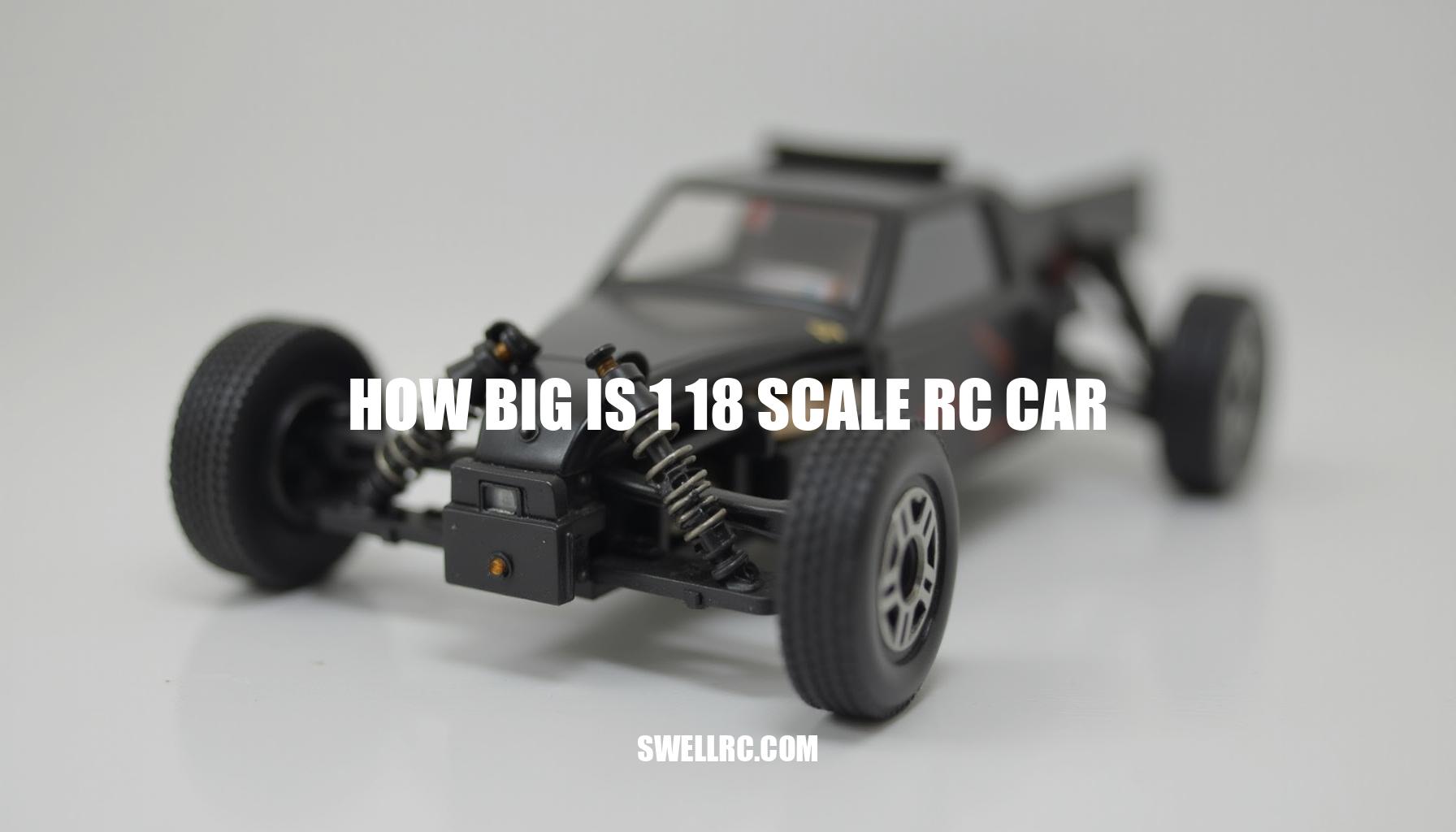How Big Is a 1/18 Scale RC Car? Dimensions and Size Guide
I used to think “1/18” meant toy-small—until I saw one ripping across a gym floor. The scale system suddenly clicked: these are scaled-down replicas with real performance DNA. In RC terms, “scale” tells you how a model’s dimensions compare to a full-size vehicle, and 1/18 lands in that sweet spot where portability meets punch.
If you’ve only handled bigger rigs like 1/5 scale RC cars, a 1/18 will surprise you with how capable it feels in hand and on mixed surfaces. This beginner RC guide will help you understand exactly how big is 1 18 scale RC car by diving into typical model car dimensions and explaining how this size affects handling, speed, and overall fun. Among the variety of RC scale sizes, 1/18 stands out in the hobby-grade RC world for offering a blend of detailed realism and practical performance, making it an excellent choice for both newcomers and experienced enthusiasts.
By the end of this guide, you’ll know where 1/18 fits in the RC universe and what kind of driving experience to expect.
Section 1: Understanding RC Car Scale Measurements
In the world of remote control vehicles, understanding model scale meaning is key to choosing the right car for your needs. The term “1/18 scale” means that the RC model is one-eighteenth the size of the full-size vehicle in every dimension. For instance, if a real car is 15 feet long (180 inches), the 1/18 scale model measures about 10 inches long (180 ÷ 18 ≈ 10).
Similarly, a 6-foot-wide vehicle (72 inches) shrinks to roughly 4 inches wide at the same scale. While actual sizes may vary slightly depending on the vehicle type—whether it’s a sedan, truck, or buggy—the math offers a reliable guideline.
To help visualize these differences, the following rc scale chart provides a quick comparison of popular scales and their typical sizes, illustrating the practical impact of rc scale conversion on car dimensions:
| Scale | Approx. Length | Features | Reference |
|---|---|---|---|
| 1/4 | 40+ inches | Professional spectacle & realism | Large-scale RC cars 1/4 |
| 1/5 | 30–35 inches | Big power, outdoor tracks | Biggest scale RC car |
| 1/10 | 16–20 inches | All-around balance | Best 1/10 scale RC |
| 1/18 | 8–10 inches | Portable, indoor/outdoor friendly | This article’s focus |
This rc size comparison clearly shows how scale affects key aspects like stability, speed potential, and turning radius. Smaller models like 1/18 scale excel in portability and are well-suited for both indoor and outdoor use, making them popular for hobbyists who need versatility. The remote control car measurements derived from these scales help enthusiasts choose the best vehicle for their driving environment and performance preferences.
Section 2: Real-World Examples — What Does a 1/18 Scale RC Car Look Like?
Most 1/18 scale RC cars, including popular 1/18 RC buggies and mini RC trucks, measure about 8–10 inches (200–255 mm) in length and 4–5 inches (100–130 mm) in width, with RC wheelbases typically ranging around 5–7 inches (130–170 mm). The tire diameter RC usually falls between 1.8–2.4 inches (45–60 mm), providing a balance of grip and speed for tight turns and quick acceleration. Weight varies from 0.8 to 1.6 lb (350–750 g), influenced by the electronics and tire choices, making these small RC race cars feel surprisingly solid and agile.
They’re easy to carry in a backpack yet stable enough to carve tight corners in a driveway or local court.
For those interested in specific models, here are some popular 1/18 scale RC vehicles that embody these characteristics:
- LaTrax Teton – offers a rugged mini monster truck feel, perfect for off-road fun.
- WLtoys A959/A959-B – a fast 4WD buggy platform known for its speed and durability.
- Team Associated RC18 series – a classic choice with a long-standing 1/18 lineage.
- HPI Micro RS4 – an on-road precision small RC race car with a compact footprint.
If you lean toward the heft and presence of larger machines, you might want to explore large RC cars for adults. However, don’t underestimate the thrill-per-foot that a well-tuned 1/18 scale RC car delivers, combining portability with impressive performance.
Section 3: Comparing 1/18 Scale with Other Popular Scales
After hours of back-to-back testing, the size differences in RC cars feel mind-blowing in practice. The 1/4 and 1/5 scales dominate open fields and beaches with their impressive presence, while 1/8 and 1/10 scales rule on specialized tracks and parking lots. For those curious about how the smaller side performs, the 1/18 scale thrives where space is limited but speed and agility still matter, offering a unique balance in the rc size guide spectrum.
| RC Scale | Typical Length (inches) | Ideal Terrain | Performance vs Portability |
|---|---|---|---|
| 1/4 | 40+ in | Fields & Beaches | High performance, low portability |
| 1/5 | 30–35 in | Fields & Beaches | High performance, low portability |
| 1/8 | 18–23 in | Tracks & Parking Lots | Balanced performance and portability |
| 1/10 | 16–20 in | Tracks & Parking Lots | Balanced performance and portability |
| 1/18 | 8–10 in | Limited Spaces | High portability, decent performance |
If you’re curious about the far extreme of RC scale comparison, check out the biggest RC car in the world. My takeaway from this 1/8 vs 1/10 vs 1/18 comparison? The 1/18 scale offers a rare mix of grab-and-go convenience, low running costs, and enough punch to keep advanced drivers grinning while still warmly welcoming newcomers.
This perfect balance makes it an excellent choice for those weighing portability vs performance in their RC hobby.
Section 4: Are 1/18 Scale RC Cars Good for Beginners and Collectors?
Choosing a 1/18 scale RC car is an excellent entry point for those seeking a balance between performance and convenience. This size offers several advantages, making it particularly appealing for rc for beginners. Its small storage footprint means you can easily keep it indoors without needing a large space, while the lighter price tags make it budget-friendly compared to larger models.
In terms of speed and power, 1/18 brushless setups significantly enhance performance, allowing top speeds of 20–30+ mph depending on gearing and battery choice.
Meanwhile, brushed motor versions typically reach 10–20 mph—adequate for casual and new hobbyists. When comparing hobby-grade vs toy-grade models, 1/18 scale vehicles tend to offer better rc durability and customization without the complexity or cost of bigger hobby-grade options.
Here’s a quick overview of the key advantages and limitations:
- Advantages: Easier transport, manageable speeds, widely available rc parts availability, and durable construction suitable for everyday use.
- Limitations: Lower ground clearance which can struggle in rough or rocky terrain, and shorter runtimes (around 10–15 minutes on typical 2S 1100–1500 mAh packs), often requiring extra batteries for extended sessions.
Collectors particularly appreciate the scale because the detailed bodies maintain a sharp, realistic appearance even at desktop size, and upgrades remain affordable. To understand how diverse the RC car world can be, check out the contrast with the most expensive RC car available (see here).
This offers a fun perspective on 1/18’s accessible charm versus the high-end extremes.
Section 5: Scale Beyond Cars — Understanding RC Size Culture
Scale isn’t just for cars. In the world of remote control vehicles, rc helicopters scale typically classifies by rotor diameter or scale ratios, while rc planes scale uses wingspan or designated scale measures. Even rc boats scale follows similar principles, emphasizing the model scale meaning to ensure consistency across types of models.
Once you grasp that “scale” is a universal language, it becomes significantly easier to choose the right size based on your available space, budget, and hobby goals. Here’s a quick hobby size guide to help:
- Micro Scale: Perfect for indoor flying or limited outdoor space, common in micro indoor helis and small planes.
- Small Scale: Ideal for beginners or casual flyers with moderate space, offering a balance between performance and size.
- Medium Scale: Suited for enthusiasts who want a realistic presence and improved flight dynamics without needing excessive space.
- Large Scale: Provides maximum realism and presence, such as large-scale warbirds, but requires ample outdoor space and a bigger budget.
Understanding scale anchors your expectations about speed, visual presence, and practicality—whether you’re piloting a nimble micro heli indoors or a detailed 1/18 scale warbird outdoors. For a more detailed breakdown of rotorcraft sizing, check out RC helicopter sizes explained. Embracing the model scale meaning across vehicles ensures you pick the perfect model tailored to your hobby environment and goals.
Conclusion: Final Thoughts on the True Size and Appeal of 1/18 Scale RC Cars
Wondering about 1/18 RC dimensions? Typically, a 1/18 scale RC car measures about 8 to 10 inches long and 4 to 5 inches wide, making it a small RC car size that’s perfect for anyone seeking balance. This size hits the sweet spot on the RC scale spectrum, offering a model that’s not only compact and portable but also capable of delivering real grip, speed, and smiles.
These portable RC cars are fast to set up, easy to transport, and provide everyday RC fun, whether you’re new to the hobby or a seasoned enthusiast. Keep in mind, scale numbers like “1/18” may seem small, but they conceal serious capability—just like the excitement you get from these nimble machines.
If you’re curious about extremes beyond the everyday, you might enjoy exploring the world’s largest RC car models, but for many, 1/18 scale remains the perfect blend of performance and convenience.
| Scale | Approximate Length | Approximate Width | Ideal For |
|---|---|---|---|
| 1/18 | 8-10 inches | 4-5 inches | Everyday fun, easy transport, indoor & outdoor use |
| 1/10 | 15-18 inches | 7-9 inches | Higher speed & detail, requires more space |
| 1/24 | 5-7 inches | 2.5-3.5 inches | Ultra portable, great for beginners and tight spaces |
- Explore different scales to find what fits your style and space
- Try various platforms to experience unique handling characteristics
- Enjoy the balance of size, speed, and maneuverability offered by 1/18 scale models
Frequently Asked Questions
- How long and wide is a 1/18 scale RC car?
Most are about 8–10 inches (200–255 mm) long and 4–5 inches (100–130 mm) wide, depending on body style and tires. - What does “1/18 scale” mean compared to real cars?
It means the model’s dimensions are 1/18 of a full-size vehicle. Divide the real car’s measurements by 18 to estimate the model’s size. - What’s the difference between 1/18 and 1/10 scale RC cars?
1/10 cars are roughly double the length of 1/18 (16–20 in vs. 8–10 in), offering more stability and off-road capability but less portability. - Are 1/18 RC cars suitable for outdoor use?
Yes, on smooth to moderately rough surfaces like asphalt, short grass, and packed dirt. Very rocky or tall-grass terrain can be challenging due to ground clearance. - What’s the best 1/18 scale RC car brand?
Popular, proven options include LaTrax (Teton), WLtoys (A959/A959-B), Team Associated (RC18 series), and HPI (Micro RS4). Choose based on parts availability in your area. - Are 1/18 scale cars considered toy-grade or hobby-grade?
Both exist. Hobby-grade 1/18 models feature replaceable parts, upgradable electronics, and better durability; toy-grade versions are cheaper but less serviceable.



